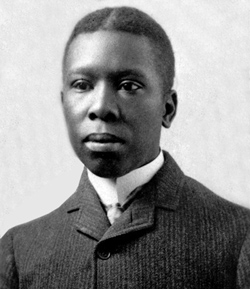By Lady Houston

FROM WIKIPEDIA COMMONS
Paul Laurence Dunbar (June 27, 1872 – February 9, 1906) was an American poet, novelist, and short story writer of the late 19th and early 20th centuries. Born in Dayton, Ohio, to parents who had been enslaved in Kentucky before the American Civil War, Dunbar began writing stories and verse when he was a child. He published his first poems at the age of 16 in a Dayton newspaper, and served as president of his high school’s literary society.
Dunbar’s popularity increased rapidly after his work was praised by William Dean Howells, a leading editor associated with Harper’s Weekly. Dunbar became one of the first African-American writers to establish an international reputation. In addition to his poems, short stories, and novels, he also wrote the lyrics for the musical comedy In Dahomey (1903), the first all-African-American musical produced on Broadway in New York. The musical later toured in the United States and the United Kingdom. Suffering from tuberculosis, which then had no cure, Dunbar died in Dayton, Ohio, at the age of 33.
Much of Dunbar’s more popular work in his lifetime was written in the “Negro dialect” associated with the antebellum South, though he also used the Midwestern regional dialect of James Whitcomb Riley. Dunbar also wrote in conventional English in other poetry and novels and is considered the first important African American sonnet writer. Since the late 20th century, scholars have become more interested in these other works.
Marriage and declining health
After returning from the United Kingdom, Dunbar married Alice Ruth Moore, on March 6, 1898. She was a teacher and poet from New Orleans whom he had met three years earlier. Dunbar called her “the sweetest, smartest little girl I ever saw”. A graduate of Straight University (now Dillard University), a historically black college, Moore is best known for her short story collection, Violets. She and her husband also wrote books of poetry as companion pieces. An account of their love, life and marriage was portrayed in Oak and Ivy, a 2001 play by Kathleen McGhee-Anderson.
In 1900, he was diagnosed with tuberculosis, then often fatal, and his doctors recommended drinking whisky to alleviate his symptoms. On the advice of his doctors, he moved to Colorado with his wife, as the cold, dry mountain air was considered favorable for TB patients. Dunbar and his wife separated in 1902, after he nearly beat her to death but they never divorced. Depression and declining health drove him to a dependence on alcohol, which further damaged his health.
Dunbar returned to Dayton in 1904 to be with his mother. He died of tuberculosis on February 9, 1906, at the age of 33. He was interred in the Woodland Cemetery in Dayton.
Legacy
Dunbar’s home in Dayton, Ohio, has been preserved as Paul Laurence Dunbar House, a state historical site that is included in the Dayton Aviation Heritage National Historical Park, administered by the National Park Service.
- His residence in LeDroit Park in Washington, DC, still stands.
- The Dunbar Library of Wright State University holds many of Dunbar’s papers.
- In 2002, Molefi Kete Asante listed Paul Laurence Dunbar among his 100 Greatest African Americans.
Numerous schools and other places have been named in honor of Dunbar, including Paul Laurence Dunbar High School in Lexington, Kentucky, Paul Laurence Dunbar High School in Dayton, Ohio, Paul Laurence Dunbar High School in Baltimore, MD, Paul Laurence Dunbar Vocational High School in Chicago, Illinois, and several others. The main library at Wright State University in Dayton and a branch library in Dallas, Texas, are also named for Dunbar, whilst the Dunbar Apartments in Harlem, New York were built by John D. Rockefeller Jr. to provide housing for African Americans. Dunbar Park in Chicago features a statue of Dunbar that was created by sculptor Debra Hand and installed in 2014.
